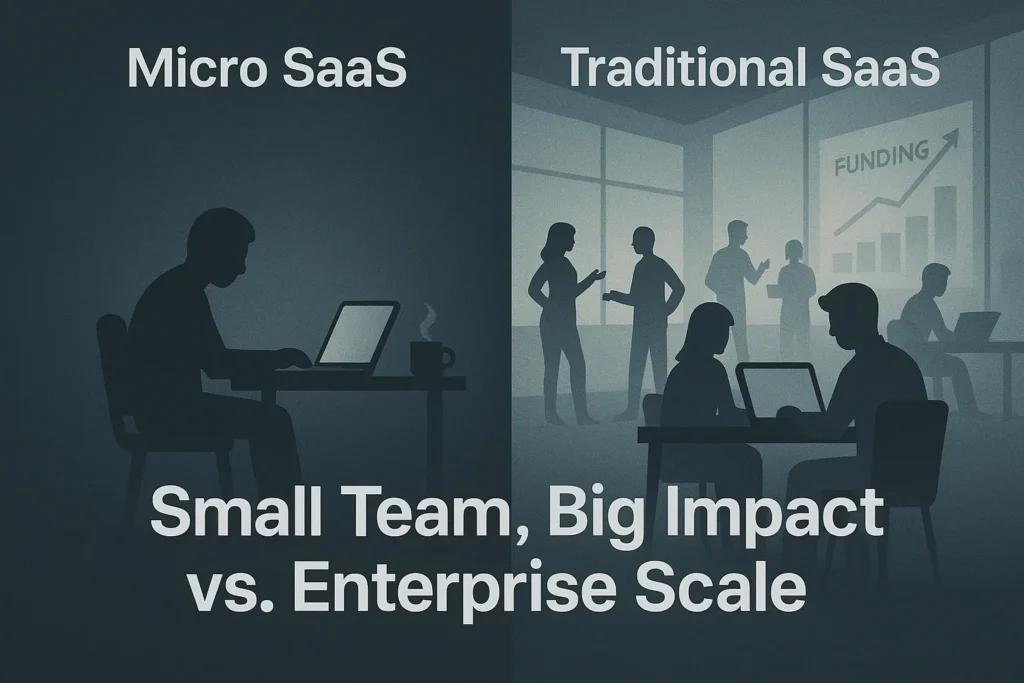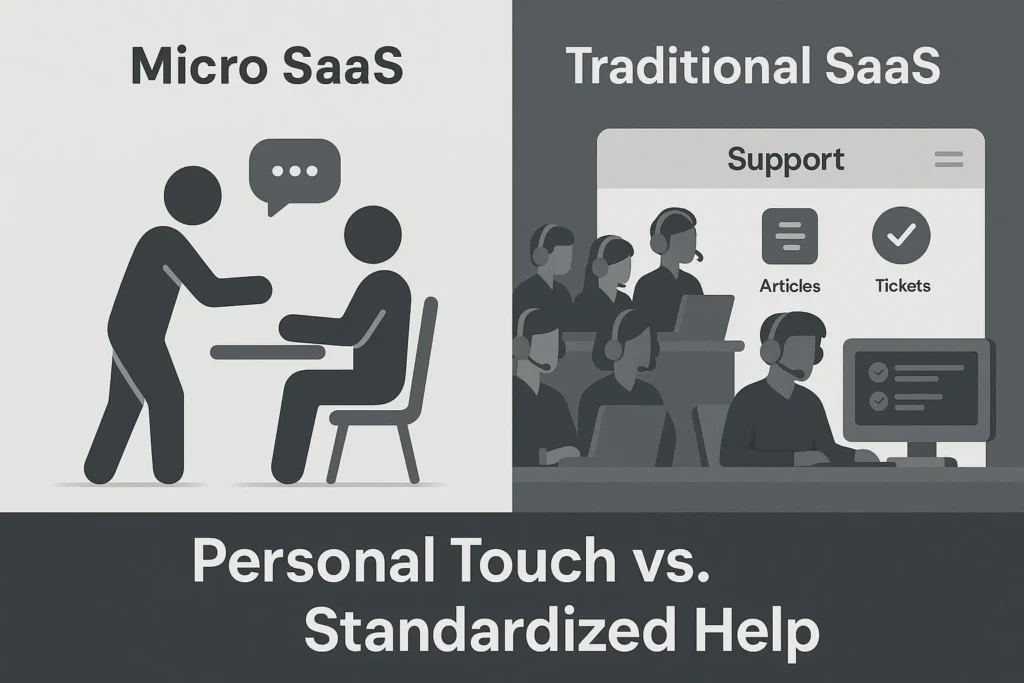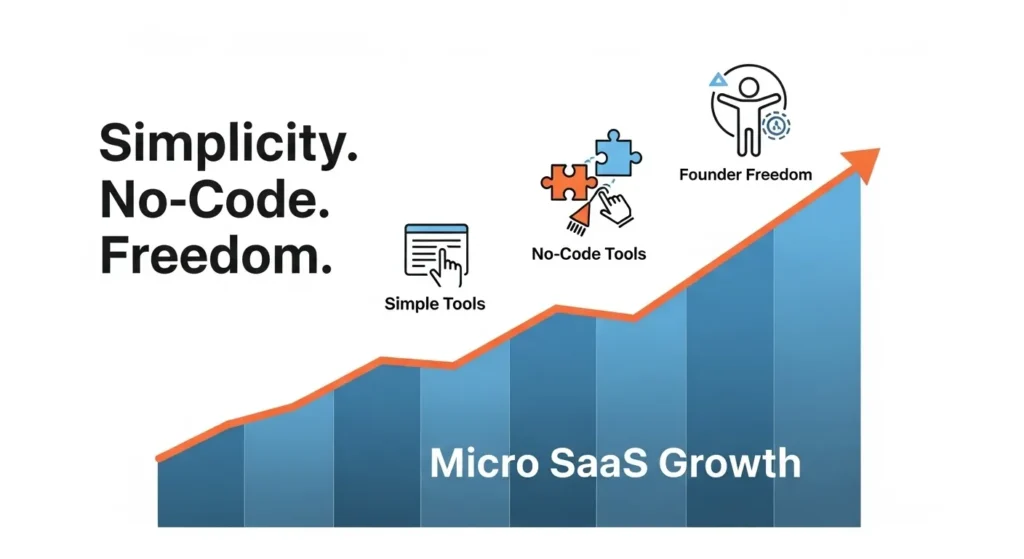Have you ever wondered about the different kinds of online software businesses? Two main types come up: traditional SaaS and Micro SaaS. While both offer software that you use over the internet without installing it, they are quite different in how they work and who they help. Understanding these differences can be super helpful, especially if you’re thinking about starting your own software business or just curious about how these companies operate.
For a full journey into building and growing your very own micro SaaS product, check out our main guide: The Ultimate Guide to Micro SaaS: From Idea to Exit.
What Does “Micro SaaS” Really Mean?
Let’s break down the micro SaaS definition. Imagine a small, clever tool designed to solve one very specific problem for a small group of people. That’s Micro SaaS! The “micro” part means it’s usually:
- Small and Focused: It doesn’t try to do everything for everyone. Instead, it picks a tiny problem and solves it perfectly. Think of a simple app that helps local bakeries manage their delivery routes, instead of a giant software for all kinds of businesses. This focus on a niche market is a key characteristic of micro SaaS.
- Built by Solo Founder or Small Teams: Often, just one person called an “indie hacker” or a very small group creates and runs a micro SaaS. This helps keep costs down and makes decisions happen much faster.
- Starts Small with Money: Most micro SaaS businesses start without big investments from outside companies. They use their own money to get going, which means the founders keep full control and can focus on making a steady profit.
- Quick to Build: Because they are so focused, these products can be built and launched fairly quickly. They start with just the main features that truly help users, and then add more later based on what customers say they need.
So, a micro SaaS product is like a specialized tool: lean, precise, and built to serve a specific, often overlooked need in the market.
Examples of Micro SaaS include:
- A browser extension that automates a specific task on a popular platform.
- A small tool for generating specific reports for freelance consultants.
- A niche plugin for a popular content management system.
- A simple app for managing specific aspects of a small business (e.g., appointment reminders for barbers).
A Quick Look at Traditional SaaS
Now, let’s think about traditional SaaS. It refers to the widely recognized model where software is licensed on a subscription basis and centrally hosted in the cloud. These are the big names like Salesforce for managing customers, Adobe Creative Cloud, or Microsoft 365. These platforms are designed to serve a broad market with comprehensive functionalities.
The main characteristics of traditional SaaS businesses include:

- Broad Market Appeal: They target a wide audience, across multiple industries or business sizes.
- Extensive Feature Sets: Their software is packed with many functions designed to address numerous problems or manage complex workflows.
- Large Teams and Departments: Traditional SaaS companies usually have large teams encompassing development, sales, marketing, support, and executive leadership.
- Significant Funding: They often rely on substantial venture capital funding to fuel rapid growth, market penetration, and continuous feature expansion.
- High Overhead and Development Costs: The complexity and scale demand significant investment in infrastructure, research and development, sales pipelines, and ongoing maintenance.
Micro SaaS vs. Traditional SaaS
The differences between micro SaaS and traditional SaaS are quite clear when you look at how they operate. It’s not about one being better than the other, but about different approaches to solving problems with software.
Who They Help (Target Audience)
Micro SaaS carefully chooses a small group of users or a very specific type of business. For example, a tool just for podcasters to quickly edit audio clips.
Traditional SaaS tries to reach a much larger group of people. Think of a general project management tool used by all sorts of companies, big and small.
What Problems They Solve (Scope)
A micro SaaS tool usually tackles just one core problem. It tries to be the very best at that one thing.
Traditional SaaS often handles many problems at once. Their software might have features for sales, marketing, customer service, and more all in one big package.
The Team Behind It (Size & Funding)
Micro SaaS often has a tiny team, sometimes just one person. They usually fund it themselves (this is called “bootstrapped”).
Traditional SaaS has big teams with many different departments. They frequently get large investments from outside investors to help them grow very fast.

How They’re Built and How Much They Cost?
Because micro SaaS is small and focused, it’s generally quicker and cheaper to build. Founders might even use “no-code” tools to create it without writing any computer code!
Traditional SaaS products are much more complex. They take a lot longer to develop and cost a lot more money to create and keep running.
Dealing with Customers (Support & Flexibility)
With micro SaaS, you might get very personal customer support, sometimes even directly from the founder! This allows them to listen closely to what users need and change the product quickly.

Traditional SaaS has structured support teams. While good, it’s harder to get that personal touch, and changing the software often takes a long time because of its size.
To truly grasp the unique appeal of Micro SaaS, it’s helpful to directly compare it with its larger cousin.
| Aspect | Micro SaaS | Traditional SaaS |
| Target Audience | Niche market, specific user segment | Broad market, diverse user base |
| Problem Solved | One specific, well-defined pain point | Multiple, comprehensive problems, complex workflows |
| Team Size | Solo founder or very small team | Large teams, multiple departments |
| Funding Model | Primarily bootstrapped, self-funded | Often venture-backed, significant external investment |
| Development | Fast, agile, MVP-focused, often no-code | Longer cycles, complex, extensive R&D |
| Cost to Build | Low to moderate | High, significant upfront investment |
| Revenue Goal | Sustainable profit, manageable recurring revenue | High growth, maximizing market share, often prioritizing valuation over immediate profit |
| Competition | Less direct competition in hyper-niche | Intense competition from numerous large players |
| Customer Support | Often direct, personal, community-driven | Scaled, departmentalized support (tickets, forums) |
| Flexibility | Highly agile, quick to pivot/iterate | Slower to pivot due to complexity and stakeholder needs |
Why Micro SaaS is Growing
The idea of Micro SaaS is becoming very popular for a few good reasons:
- People Want Simple Tools: Many users are tired of software that has too many features they don’t need. They want simple, effective tools.
- Accessibility of Easier to Build Software: No-code/low-code platforms, affordable cloud hosting, and vast open-source resources make it easier than ever for individuals to build and launch software. Even they don’t know how to code.
- Freedom for Founders: Entrepreneurs like the idea of owning their business completely and building something that creates a steady income without the stress of big company demands.
- Validation through Niche: Focusing on a niche allows for quicker market validation and direct customer feedback, reducing risk.

While traditional SaaS aims to be a big, all-encompassing solution, Micro SaaS model focuses on being the best small solution for a specific group of people. Both are valuable, but Micro SaaS offers a unique, lean path for entrepreneurs to create useful software and build a sustainable business.

